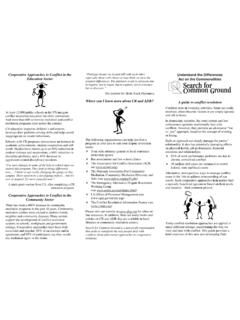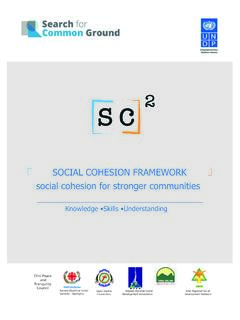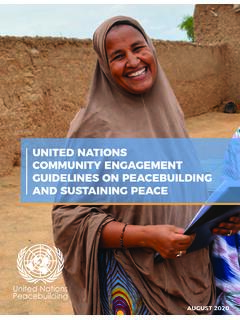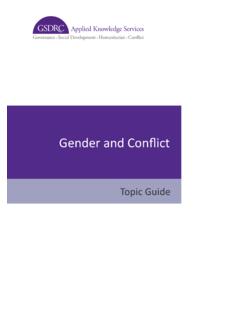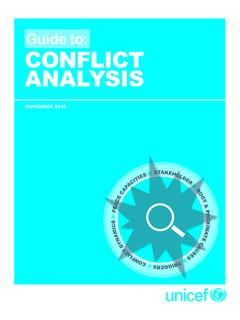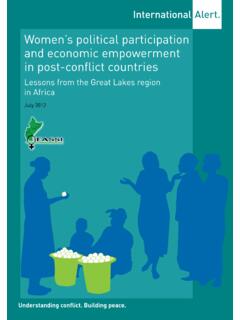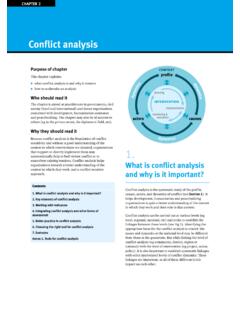Transcription of The Community Peacebuilding Project
1 The Community Peacebuilding Project Final Evaluation Report Implemented by Search for Common Ground Prepared by: Sadeq Noman Al-Nabhani Email: Shoqi Abas Country Director SFCG-Yemen Search for Common Ground St. No. 6, off Amman St., Villa No. 4, Sana'a, Yemen +967 1 442 308/9. 1. Contents ACKNOWLEDGEMENTS 4. ABBREVIATIONS AND ACRONYMS 5. 1. EXECUTIVE SUMMARY 6. Salient findings: 7. Conclusions 9. Recommendations: 10. 2. Project DESCRIPTION 11. PURPOSE AND SCOPE OF THE EVALUATION 11. 3. METHODOLOGY 13. 4. FINDINGS OF THE EVALUATION: 15. Relevance 15. Relevance to the Community needs and existing issues: 15. Relevance of the interventions as perceived by beneficiaries and external observers? 17. Relevance of the instruments used to the local communities' needs and capacities: 18.
2 Effectiveness 19. Success in achieving the Project stated goal? 19. Success in achieving the Project stated objectives: reducing the risk of inter-communal violence through dialogue processes and mitigating the risk of future conflicts 20. Effectiveness of the Project in providing Insider Mediators with the skills and capacities needed to increase Community resilience to violence. 21. Effectiveness of the Project in reducing the risk of inter-communal violence through dialogue processes 23. Effectiveness of the Project in mitigating the risk of future conflicts 25. Contribution of the various Project activities to the achievement of Project objectives 26. Key factors influencing the achievement or non-achievement of the objectives: 28.
3 Key Challenges: 29. Efficiency: 29. Sustainability 31. Impact: 32. Assessment of the impact of Conflict Resolution Committees in the districts targeted in Phase I 37. 5. CONCLUSIONS 41. 2. 6. RECOMMENDATIONS 42. 7. Project Indicators 44. Annex (1): 47. Annex (2): 52. Annex (3): 54. Annex (4): 74. 3. ACKNOWLEDGEMENTS. The evaluator would like to extend sincere gratitude to all those who supported the evaluation process. I. am extremely grateful to all Search and Project Staff who shared their time, experience, and knowledge about the Project and priority issues in the targeted communities. I would like to acknowledge, in particular, the insight and support bestowed by Ms. Limou Dembele, the Design, Monitoring & Evaluation Specialist for the MENA region, who provided me with invaluable analysis, review, and feedback.
4 Special gratitude goes to Ms. Mona Al-Ariqi, the Project Manager, and to Salman Abdo Ahmed, the Monitoring &. Evaluation Officer, who supported the team throughout the evaluation process. I would also like to express my gratitude to and acknowledge the role and support of Mr. Shoqi Maktary, Search-Yemen's Country Director, for sharing invaluable information, knowledge, and experience on the Project and related interventions. A special thank you goes to the field teams who collected quantitative and qualitative data, conducted the focus group discussions, and implemented the required tasks to a high standard, despite the ongoing war and unstable security situations in the targeted governorates and districts.
5 The field team included: Ahmed Abdulrahman Al-Same'ei, Lina Ali Mahyob Al-Ariqi, Badr Al-Khulaidi, Samira Al-Asbahi, Adhb Aziz, Sami Saif Jayoob, Mansour Husain Thabet, Layla Faisal Mhmoud, Hakeem Ahmed Ali Boslum, Tasneem Nayel Fare'e Ali, Arafat Mohamed Bazel, Maha Al-Aqhali, Abeer Mohamed Abdulwahed and Abdulwahab Ahmed Abdulrab. Last but not least, thank you to Mr. Ali Salah Al-Marsi, who created a very helpful database compiling collected data and relevant statistical analysis information. The External Evaluator, Sadeq Al-Nabhani 4. ABBREVIATIONS AND ACRONYMS. CDA Community Dialogue Approach CLs Community Leaders CRC Conflict Resolution Committee CSO Civil Society Organisation CSSF The Conflict, Stability and Security Fund FGD Focus Group Discussion GoY Government of Yemen HR Human Resources IMs Insider Mediators IP Implementing Partner KIIs Key Informant Interviews NGO Non-Government Organisation OECD-DAC The Organization for Economic Co-operation and Development.
6 Development Assistance Committee. SDG Sustainable Development Goals Search Search for Common Ground ToR Terms of Reference 5. 1. EXECUTIVE SUMMARY. The war in Yemen has led to one of the largest humanitarian crises of our time. In addition to local conflicts over limited resources, such as water and land, political conflicts breed highly volatile social environments, characterised by the frequent dissolution of public services. The conflict has led to a dire humanitarian situation, with an increasing number of civilian deaths and casualties; the destruction of infrastructure;. the disruption of trade, commerce and supplies; acute food shortage; and the massive internal displacement of people. As of 15 October 2017, health facilities reported 8,757 conflict related deaths and over 50,610 injuries, and over three million people have been forced to flee from their All parties to the conflict have repeatedly violated their obligations under International Humanitarian Law, and civilian infrastructure, including schools, health facilities, and markets have been subject to attacks.
7 Reports of grave violations of child rights and gender-based violence have increased. Millions of people in Yemen need humanitarian assistance to ensure their basic survival. An estimated million are food insecure, 16 million lack access to safe water and sanitation, and million lack access to adequate healthcare. Needs across the country have grown more acute since June 2017, with million in urgent need of humanitarian assistance in order to survive a number which has increased by 15% in five The recent outbreak of cholera, in the absence of basic services, is meanwhile rapidly claiming more lives in the country's poorest regions. The governance institutions and capacities, both at central and local levels, are weak, and civil society participation in public affairs is limited.
8 It is within this context that the The Community Peacebuilding Project ' was designed and implemented. Search's mission in Yemen is to promote a culture of dialogue and diversity through the involvement of all components of society, while reinforcing their capacities. Search-Yemen works in the ongoing conflict to help members of Yemeni society approach conflict and differences in a constructive manner, through cooperation and dialogue. This final evaluation report was conducted to provide an independent assessment of the added value of Search's interventions in Yemen. This assessment will take into account beneficiary perspectives, as well as the evaluated effectiveness, efficiency, impact, and sustainability of the implemented Project .
9 It will also aim to document lessons learned and to provide practical recommendations to improve design and implementation, and regarding the identification of future priority areas. The evaluation was based on OECD-DAC Peacebuilding Evaluation Criteria (relevance, effectiveness, impact, efficiency and sustainability), through investigating the questions provided within these criteria and utilising the performance indicators described in the Project document. In addition, this evaluation provides an independent assessment of the impact of Conflict Resolution Committees (CRC) -- which were established in the districts targeted in Phase I --, on Community resilience to violent conflict, and on mitigating the risk of future conflict.
10 Al-Shamayatain district, in Taiz Governorate, was used as a sample. Qualitative and quantitative tools were used to gather evaluation data from the six targeted districts, as well as Al-Shamayatain district. For this purpose, 51 Key Informant Interviews (KIIs) were conducted with key stakeholders, including Project staff, Insider Mediators (IMs), trainees, and local partners. Fourteen 1. Humanitarian Needs Overview, UNOCHA, 2018. 2. Humanitarian Needs Overview, UNOCHA, 2018. 6. focus group discussions (FGDs) were organised with IMs and Community leaders (CLs) at a rate of two FGDs per governorate. In addition, individual survey interviews were conducted with 556 of the Community members involved in the different Project activities, in the six targeted districts and in Al- Shamayatain district.

